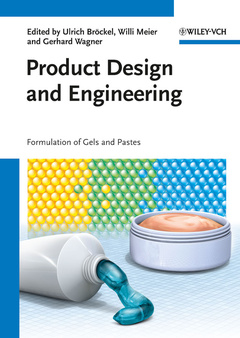Product Design and Engineering Formulation of Gels and Pastes
Coordonnateurs : Bröckel Ulrich, Meier Willi, Wagner Gerhard

Covering the whole value chain - from product requirements and properties via process technologies and equipment to real-world applications - this reference represents a comprehensive overview of the topic. The editors and majority of the authors are members of the European Federation of Chemical Engineering, with backgrounds from academia as well as industry. Therefore, this multifaceted area is highlighted from different angles: essential physico-chemical background, latest measurement and prediction techniques, and numerous applications from cosmetic up to food industry.
Recommended reading for process, pharma and chemical engineers, chemists in industry, and those working in the pharmaceutical, food, cosmetics, dyes and pigments industries.
RHEOLOGY OF DISPERSE SYSTEMS
Introduction
Basics of Rheology
Experimental Methods of Rheology
Rheology of Colloidal Suspensions
Rheology of Emulsions
RHEOLOGY OF COSMETIC EMULSIONS
Introduction
Chemistry of Cosmetic Emulsions
Rheological Measurements
Dynamic Mechanical Tests (Oscillation)
RHEOLOGY MODIFIERS, THICKENERS, AND GELS
Introduction
Classification of Thickeners and Gels
Definition of a ``Gel??
Rheological Behavior of a ``Gel??
Classification of Gels
Particulate Gels
Rheology Modifiers Based on Surfactant Systems
USE OF RHEOLOGICAL MEASUREMENTS FOR ASSESSMENT AND PREDICTION OF THE LONG-TERM ASSESSMENT OF CREAMING AND SEDIMENTATION
Introduction
Accelerated Tests and Their Limitations
Application of High Gravity (g) Force
Rheological Techniques for Prediction of Sedimentation or Creaming
Separation of Formulation (``Syneresis??)
Examples of Correlation of Sedimentation or Creaming with Residual (Zero Shear) Viscosity
Assessment and Prediction of Flocculation Using Rheological Techniques
Examples of Application of Rheology for Assessment and Prediction of Flocculation
Assessment and Prediction of Emulsion Coalescence Using Rheological Techniques
PREDICTION OF THERMOPHYSICAL PROPERTIES OF LIQUID FORMULATED PRODUCTS
Introduction
Classification of Products, Properties and Models
Pure Compound Property Modeling
Functional Bulk Property Modeling ? Mixture Properties
Functional Compound Properties in Mixtures ? Modeling
Performance Related Property Modeling
Software Tools
Conclusions
SOURCES OF THERMOPHYSICAL PROPERTIES FOR EFFICIENT USE IN PRODUCT DESIGN
Introduction
Overview of the Important Thermophysical Properties for Phase Equilibria Calculations
Reliable Sources of Thermophysical Data
Examples of Databases for Thermophysical Properties
Special Case and Challenge: Data of Complex Solutions
Examples of Databases with Properties of Electrolyte Solutions
Properties of New Component Classes: Ionic Liquids and Hyperbranched Polymers
CURRENT TRENDS IN IONIC LIQUID RESEARCH
Introduction
Ionic Liquids as Acido-basic Media
Binary Mixtures of Ionic Liquids: Properties and Applications
Nanoporous Materials from Ionothermal Synthesis
Catalytic Hydrogenation Reactions in Ionic Liquids
Concluding Remarks
GELLING OF PLANT BASED PROTEINS
Introduction ? Overview of Plant Proteins in Industry
Structure and Formation of Protein Gels
Factors Determining Physical Properties of Protein Gels
Evaluating Gelation of Proteins
Gelation of Proteins Derived from Plants
Protein Gels in Product Application
Future Prospects and Challenges
ENZYMATICALLY TEXTURIZED PLANT PROTEINS FOR THE FOOD INDUSTRY
Introduction
Reactions Catalyzed by MTG
Current Sources of MTG
Need for Novel Sources of MTG
Vegetable Proteins Suitable for Crosslinking with MTG
Strategies to Modify and Improve Protein Sources for MTG Crosslinking
Applications of MTG in Processing Food Products Containing Vegetable Protein
Applications of MTG Crosslinked Leguminous Proteins in Food Models and Realistic Food Products
Safety of MTG and Isopeptide Bonds in Crosslinked Plant Proteins
Conclusions
DESIGN OF SKIN CARE PRODUCTS
Product Design
Skin Care
Emulsions
Structure of a Skin Care Cream
Essential Active Substances from a Medical Point of View
Penetration into the Skin
Targeted Product Design in the Course of Development
Production of Skin Care Products
Bottles for Cosmetic Creams
Design of all Elements
EMULSION GELS IN FOODS
Introduction
Food Emulsions
Creating a Food Emulsion
Applications of Gel-Like Type Emulsions
Final Considerations
INDEX
Willi Meier studied chemistry at the RWTH Aachen, where he gained his PhD in 1992. He is responsible for the international cooperation of the DECHEMA and is coordinating the research activities of the section groups of the EFCE and the European Federation of Biotechnology.
In 2013, he was appointed honorary professor at the Technical University of Clausthal.
Gerhard Wagner studied chemical engineering at the Technical University of Munich, where he gained his PhD. He has since held different scientific and managerial positions in R&D at Hoffmann-La Roche in Switzerland and DSM in Europe, US and China. After leading the
Formulation R&D Department, and being responsible for the R&D strategy development and acquisitions and integrations of R&D groups worldwide, he is currently the Vice President and global R&D director of the DSM Biotechnology Center in Delft and Shanghai. Dr. Wagner
co-chairs the section group ''Product Design and Engineering'' within the EFCE.
Date de parution : 11-2013
Ouvrage de 372 p.
17.8x24.6 cm
